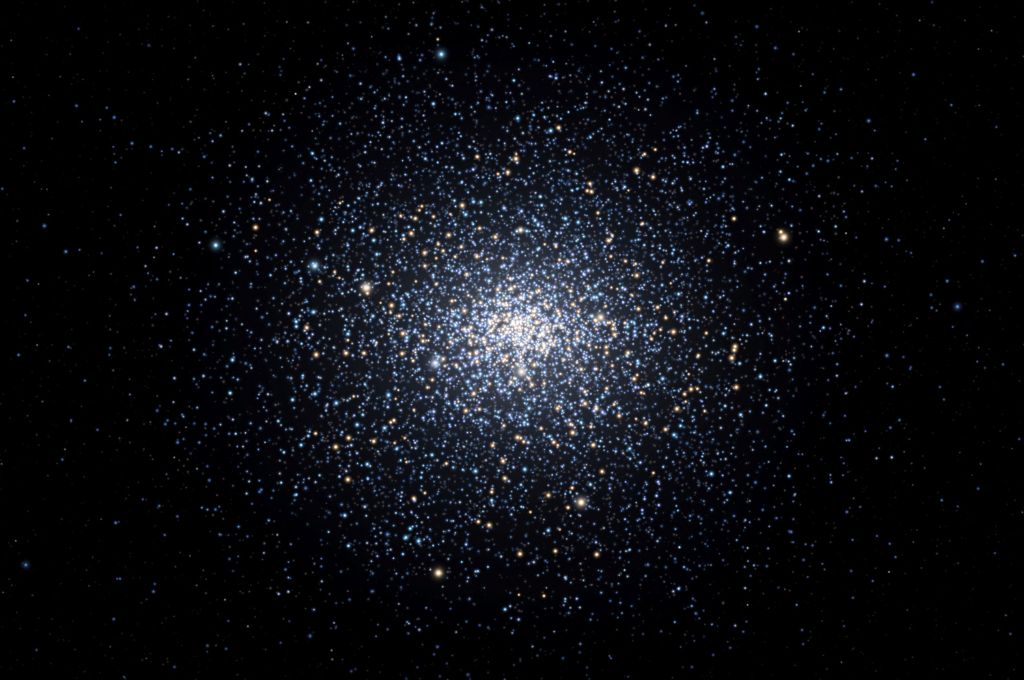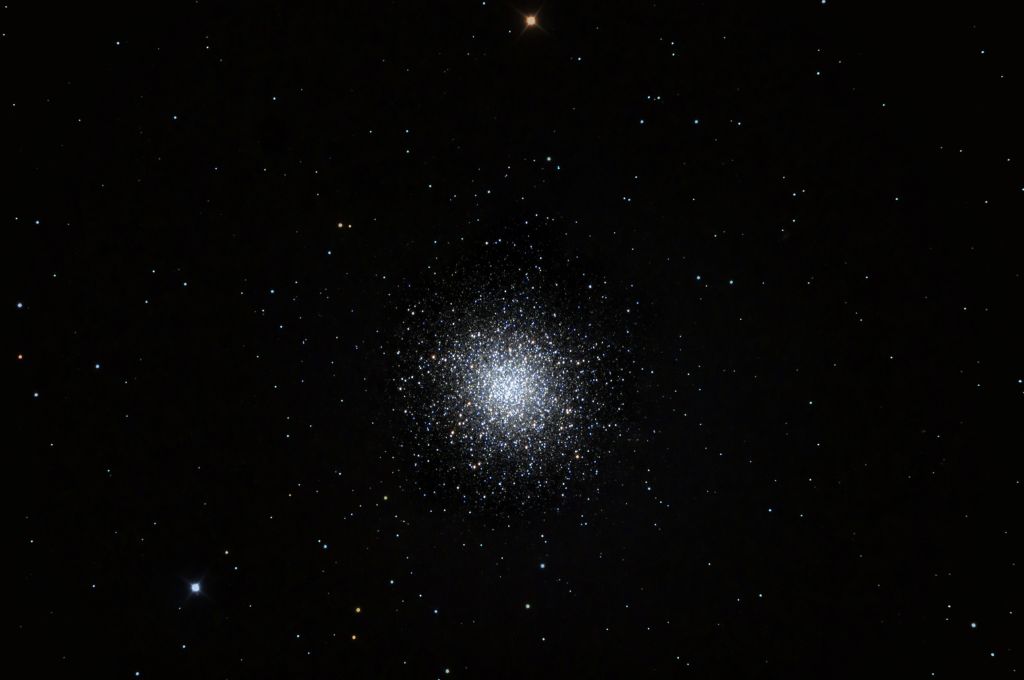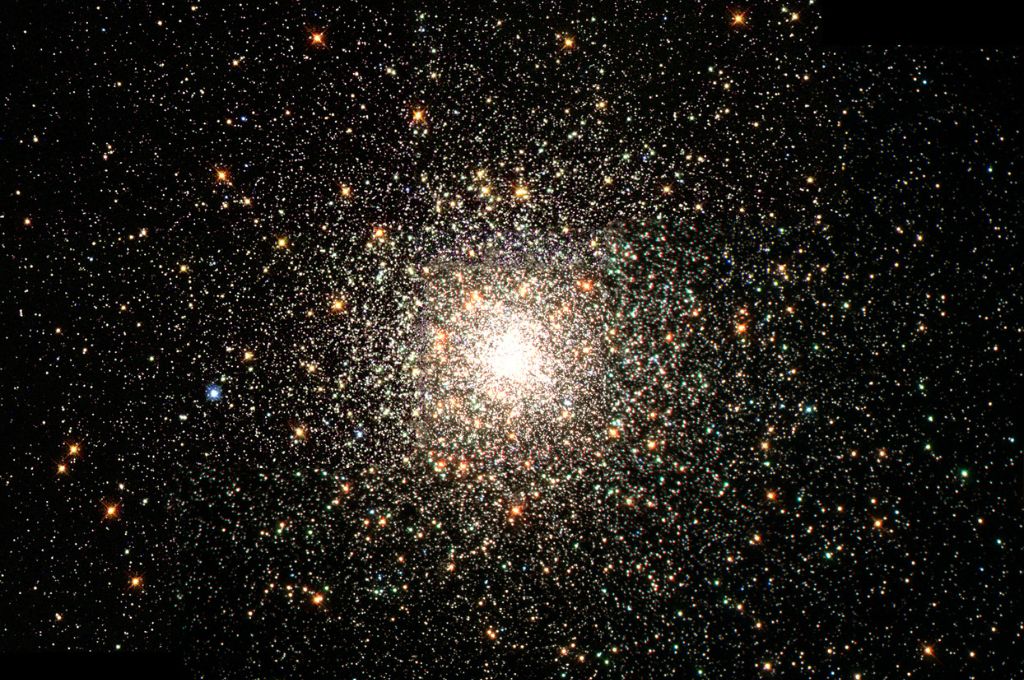When you think of star clusters, the chances are you think of a scattering of stars, like the Pleiades or the Beehive.
However, there’s another common type that’s popular with amateur astronomers everywhere: the globular star cluster. While not as numerous as their open star cluster cousins, nearly two hundred are currently known to exist, with 140 of those belonging to our own Milky Way galaxy. Of the 110 objects in the Messier catalog, 29 are globular clusters, while another 133 can be found in the comprehensive New General Catalog (NGC).
So then, what exactly is a globular star cluster? And which are the best ones to observe?
What is a Globular Star Cluster?
In a sense, a globular star cluster is a little like a swarm of bees, except that every bee is, in fact, a star. As their name implies, globular star clusters are roughly spherical in shape and typically contain hundreds of thousands of stars, all crammed within an area of space only 10 to 30 light-years in diameter.
To use a simple example, if a globular cluster has 200,000 stars and is 20 light-years in diameter, that means you’ll find roughly 500 stars within every cubic light-year of space!
Obviously then, any planet in a globular would have a sky full of stars, and while there could be thousands of planets in each cluster, just one exoplanet has been found so far.
That’s just one mystery tied to globulars, with another being their location.
Many of them can be found in the galactic halo, a shell of clusters, stars, gas and dust that surrounds the core of the galaxy. As such, while open star clusters typically lie hundreds or thousands of light-years away, globular clusters tend to be tens of thousands of light years away, with the furthest Milky Way globular an estimated 472,000 light-years away!
All galaxies have globular clusters, with some globulars in other galaxies even being visible with amateur equipment. For example, M31, the Andromeda Galaxy, has an estimated 300-400 globular clusters, with a number of these being visible in apertures of 250mm or larger.
Lastly, unlike open star clusters, which predominantly contain young stars, globular star clusters are often made up of much older stars, with many thought to be more than ten billion years old. That makes them hundreds of times older than open star clusters, which are typically tens of millions of years old.
While we have yet to solve these mysteries, astronomers have a number of theories, with the answers potentially coming from gaining a better understanding of the clusters’ origins.

How Do Globular Star Clusters Form?
The process by which open stars clusters form is fairly well understood, but the same can’t be said for globulars. Current thinking is that they were born when the host galaxy itself was forming, and that they originate from more active star-forming regions, made up of denser gas and dust. This would result in a greater number of stars being formed within closer proximity to one another, thereby also ensuring that the member stars remain gravitationally bound to one another.
This would help to explain why globular clustes are primarily made up of older stars; since their close proximity would result in their remaining together for their entire stellar lives. This contrasts with open star clusters, whose members are not bound together and will often drift apart over time.
More specifically, when it comes to open star clusters, you’ll looking at young stars that have yet to drift away from one another. However, when you look at globular clusters, you’re looking at much older stars, that formed at around the same time as their host galaxy, and that never drifted apart because their mutual gravity kept them close together.
One other theory states that some globulars may be the cores of dwarf galaxies. The larger galaxy may have robbed the dwarf galaxy of its outer stars, leaving just its core behind. This core, in the form of a globular cluster, would then orbit the center of the larger galaxy that consumed it.
Want to get started in astronomy?
Our free telescope cheat sheet breaks down the key factors to choosing a telescope and shows you how to get stunning views of planets, nebula, and galaxies!

It’s also worth noting that some globulars contain a mix of younger and older stars. More specifically, some members may belong to one age group, whereas others might belong to a younger generation. It’s thought this happens when the cluster interacts with a molecular cloud of gas and dust, which then sparks star formation and results in the younger generation of stars being born.
As for the lack of planets, there are two potential explanations. Firstly, the stars in globular clusters formed when the universe was relatively young and lacking in the heavier elements required to form planets. Secondly, that many stars within such a small area (remember, potentially 500 stars within a cubic light-year of space) would make it difficult for planets to form at all.

A Brief (Observational) History of Globular Star Clusters
Since many globular clusters lie at a greater distance than open clusters, they typically appear smaller and fainter. Consequently, although a number of open star clusters are visible to the naked eye and have been known for millennia, the same can’t be said of globulars – with one exception.
Omega Centauri has a magnitude of just 3.7, making it easily visible to the naked eye. This helps to explain its name, as it was mistaken for a star in pre-telescopic times. Little surprise that it’s the brightest of its kind, but while there are a few others that lie on the edge of naked-eye visibility (most notably, 47 Tucanae), they would all appear starlike until the invention of the telescope in the early 17th century.
The telescope revolutionalized astronomy, with new discoveries coming thick and fast. Despite its brightness, Omega Centauri wasn’t the first globular cluster to be positively idenitified; unfortunately, like 47 Tucanae, it lies in a southern hemisphere constellation and barely rises over Europe, where many of the discoveries were taking place.
Instead, that honor went to M22, another large and bright globular star cluster, in the slightly more northerly constellation of Sagittarius. At magnitude 5.1, it lies on the edge of naked eye visibility, and is easily found just 2.4 degrees east of Kaus Borealis, the bright star that marks the lid of the Teapot asterism. However, again, without the use of binoculars or a telescope, you’d simply mistake it for a star.
M22’s discovery is credited to the German amateur astronomer Johann Abraham Ihle in 1665, with the discovery of Omega Centauri’s non-stellar nature coming 12 years later, courtesy of Sir Edmond Halley. Unfortunatey, the inferior quality of the telescopes at that time could only show the clusters as tiny, misty patches, leading astronomers to believe they were actually small nebulae, rather than star clusters.
The Discoveries of the 18th Century
The French astronomer Charles Messier was the first to resolve the individual stars of a cluster (M4) in 1764, and by the time he published the first edition of his famous catalog in 1774, 24 globulars had been discovered. Messier himself discovered 9 of those, with his first catalog of 45 objects including 14 globulars.
The final edition of Messier’s catalog contained 103 objects in total, of which 29 were globulars, with the brightest being the aforementioned M22 (mag 5.2) and the faintest being M72 (mag 9.2). Published in 1781, this was the same year that the Anglo-German astronomer William Herschel discovered the planet Uranus, and it was Herschel who would then lead the way with globulars.
Herschel was responsible for the discovery of another 36 clusters, and thanks to the the superior optics of his equipment, he was able to resolve the individual stars of each of the clusters he discovered.
He quickly realized that there were, in fact two types of star cluster, and he categorized each of the known clusters accordingly: either the cluster was a loosely bound, irregularly-shaped open star cluster, or a tightly-bound globular star cluster.
The Shapley-Sawyer Concentration Class
By the late 1920’s, both the New General Catalog (NGC) and Index Catalog (IC) of deep sky objects had been published, bringing the total number of known globular clusters to more than 140. Then, from 1927 to 1929, two Harvard astronomers, Harlow Shapley and Helen Sawyer Hogg, worked to devise a classification system for these clusters, based upon the concentration of stars toward the cluster’s core.
There are twelve levels of concentration in the system, each represented by Roman numerals, with the densest having a classification of I and the least concentrated having a classification of XII.
| Class | Description | Examples |
| I | Highly concentrated toward the center | M75, M80* |
| II | Dense central concentration of stars | M2, M80* |
| III | Strong inner concentration of core stars | M54 |
| IV | Intermediately rich concentration of core stars | M15, M28, M62, M92 |
| V | Intermediate concentration of core stars | M5, M13, M30, M53, M69, M70, M79 |
| VI | Intermediately mild concentration of core stars | M3 |
| VII | Intermediately loose concentration of core stars | M10, M22 |
| VIII | Rather loose concentration of core stars | M9, M14, M19 |
| IX | Loosely concentrated toward the core | M4, M12, M72 |
| X | Very loosely concentrated core stars | M56, M68, M71*, M107 |
| XI | Almost no concentration of core stars | M55, M71* |
| XII | No concentration of core stars | Palomar 12 |
While this system exists, to some extent the classification of an individual cluster is a subjective matter, and there are some clusters that will appear in more than one category. For example, in the table above, both M71 and M80 have been classified as two types.
How to Observe Globular Star Clusters
Unfortunately, Omega Centauri and 47 Tucanae are the only globulars easily visible to the naked eye – and you’ll need to be in the southern hemisphere to see them. However, that’s not to say there aren’t many others you can spot with binoculars and observe with telescopes of all sizes.
However, before you start, it’s worth taking a little time to prepare. For starters, you’ll want to be as far away from the lights of any towns or cities, as this stray light (called light pollution) will brighten the sky and make it difficult, or impossible, to see the fainter objects.
Secondly, you’ll want to allow at least 30 minutes for your eyes to become fully adapted to the dark. This will allow you to not only see fainter objects, but to also see more detail.
Lastly, if you’re using a telescope (especially a reflector), it’s a good idea to allow it to adjust to the ambient air temperature outside. Telescopes that are stored indoors will trap the warmer air inside the tube; if this air is not given time to cool and match the temperature of the air outside, then the warmer air currents in the tube can cause distortion.
The amount of cool-down time needed will vary, depending on the aperture, with smaller scopes taking less time. For example, a small scope typically takes around 30-45 minutes, while larger apertures can take hours. If you’re not sure how long it should take, it’s a good idea to consult with the manufacturer or to seek advice from a local group or online forum.
Since globular clusters are condensed spheres of stars, you might think they’ll look very similar through the eyepiece, but that’s not the case. Globular clusters provide challenges that you simply don’t get with regular open clusters. For example, at first glance, a globular may appear as simply a small, misty circular patch, but take a little time to look more carefully and you’ll start to see more.
For starters, what shape is it? Some globulars appear a little elliptical, while others are almost perfectly circular. Does it have a bright core, or does it appear to be of uniform brightness throughout? How large is the core? What shape is it? Not all cores are circular!
Can you resolve the cluster into its individual stars? And if so, can you only resolve the outer portion (called the halo) or can you resolve it all the way to the cluster’s core? (Since globulars often appear nebulous, it can be hard to fine-tune the focus for the best resolution. If this is the case, try focusing the image by using a nearby star within the same field of view as a reference point.)
What other features do you see? Some clusters will show chains of stars curling out from the core, or tiny clumps of stars scattered throughout the halo. You might also see darker areas where the stars are not so populous or bars of stars across the core.
The Best Globular Star Clusters
With nearly two hundred globulars to choose from, you may be wondering where to start. Fortunately, there are a handful that stand out due to their brightness, location and characteristics. With that in mind, here’s a selection of the best globular clusters in the night sky.
- 47 Tucanae – One of the few globulars bright enough to be seen without optical aid, 47 Tucanae is only slightly fainter and smaller than Omega Centauri. It can be found just to the west of the Small Magellanic Cloud, and has the appearance of a slightly fuzzy star to the naked eye, while telescopes will easily resolve its individual stars.
- M4 – Easily found, M4 can be found between the stars Antares and Al Niyat in Scorpius, and at magnitude 5.6, can be detected with binoculars. However, point a telescope toward it and something unexpected soon becomes apparent. Even small telescopes and a modest magnification of around 45x will show a bar of stars crossing its core, while countless individual stars become apparent at around 80x.
- M13 (The Great Hercules Cluster) – The globular showpiece of the northern celestial hemisphere, M13 is large, bright (magnitude 5.8) and conveniently located between Eta and Zeta Herculis. Through a small telescope, you’ll see some resolution at a magnification close to 100x, while increasing the power will show chains of stars curving out from the core. Larger apertures (around 250mm) and a magnification of around 200x will also reveal three dark lanes forming a Y-shape near the center.
- M22 – Just two degrees east of Kaus Borealis in Sagittarius, M22 is also large and bright (magnitude 5.2), making it easy to spot with binoculars. Telescopically, it appears uniformly bright and is easily resolved, with dozens of stars being visible with a small telescope at around 50x. Larger scopes will show individual stars against the unresolved core, which itself extends roughly halfway to the cluster’s edge.
- NGC 5139 (Omega Centauri) – The brightest and largest globular in the sky, Omega Centauri can be found with the naked eye by using the stars Beta (Hadar) and Epsilon Centauri (BIrdun) as pointers. It appears large and slightly elliptical in binoculars, while telescopes will show thousands of individual stars scattered evenly across the field of view. If you have a larger scope (around 400mm or more) you may also be able to spot a few red supergiants within it.







